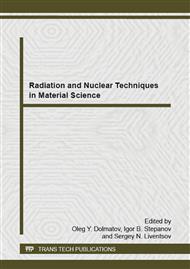p.536
p.540
p.545
p.549
p.554
p.559
p.567
p.572
p.577
New Porphyrins/Calf Thymus DNA Complexes - Their Thermostability
Abstract:
The paper studies the melting parameters of the complexes of water soluble cationic 3N- and 4N-pyridyl porphyrins with different peripheral substituents (oxyethyl, buthyl, allyl, metallyl) with DNA. The results indicate that the presence of porphyrin changes the shape and parameters of DNA melting curve. The porphyrin concentration increase results in the increase of the melting temperature (Tm) and melting interval (ΔT) of DNA. With the porphyrin-DNA concentration ratio ν = 0.01, changes of melting temperature have not been observed. The melting intervals almost do not change upon the addition of the 4N- porphyrins, while the decrease of ΔT is observed in the presence of 3N-porphyrins. Because of the intercalation binding mechanism occurring in GC-rich regions of DNA, we assume that 3N-porphyrins intercalated in GC-rich regions, reduce the thermal stability of these sites, bringing them closer to the thermal stability of the AT-sites, which is the reason for the decrease in melting interval. While with the relative concentration ν = 0.01 for 4-N porphyrins the external binding mechanism “turns on” and destabilizing effect of porphyrins on GC-pairs compensated by their stabilizing effect on AT-pairs. As a result, no change in the melting parameters of DNA is observed upon complexation with these porphyrins.
Info:
Periodical:
Pages:
554-558
Citation:
Online since:
January 2015
Authors:
Keywords:
Price:
Сopyright:
© 2015 Trans Tech Publications Ltd. All Rights Reserved
Share:
Citation:


